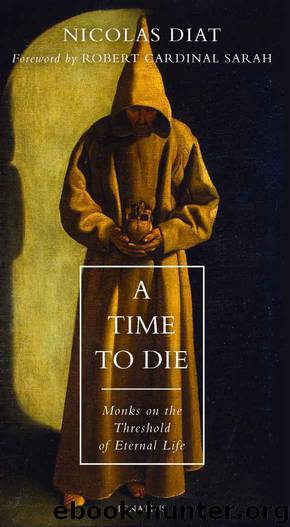A Time to Die by Nicolas Diat

Author:Nicolas Diat [Diat, Nicolas]
Language: eng
Format: epub
Tags: Spiritual & Religion
ISBN: 9781621642749
Publisher: Ignatius Press
Published: 2019-08-05T04:00:00+00:00
V
Rainy Days
Cîteaux Abbey
On March 21, 1098, under the direction of Abbot Robert, twenty-one monks from Molesmes Abbey arrived at a secluded place. In the heart of the marshy forest of Cîteaux, they wanted to live together in a more authentic way, according to the rule of Saint Benedict. The early stages were difficult. The abbey was distancing itself from the Cluniac order’s extravagance, but it attracted few novices.
In 1113, the hand of God seemed to come to the help of the reformer monks. Etienne Harding, third abbot of Cîteaux, welcomed Bernard de Fontaine, who arrived with some thirty companions wanting to be formed in the monastic life. In 1115, Bernard in turn left to establish the abbey of Clairvaux. The charisma and tenacity of this young man assured the order a rapid growth, and the foundations multiplied. The Cistercian epic was beginning. It would not stop. In 1153, at the death of Saint Bernard, the order of Cîteaux numbered three hundred monasteries of men. By the end of the twelfth century, there were five hundred. . .
When coming to Cîteaux, how can one envision and rediscover the traces of this past glory? On a rainy day in May, I arrived from Dijon to spend a few days in the historic abbey, after having crossed the lush, rich Burgundian countryside. The metallic sky oscillated between gray, black, and violet. Huge clouds were rolling toward the forests of Nuits-Saint-Georges.
In passing through the beautiful gate that opened onto a long drive, I was struck by the austerity, bareness, and gravity of the place. The Cistercians have always cultivated an ascetic detachment; it was normal for the radicality of the place to affect my view.
The monastery is organized around an imposing eighteenth-century building, the Lenoir wing, where the ground floor gallery measures almost 110 yards long. In the gardens, at the center of a perfectly mowed lawn, a giant crucifix stands in front of the building. In the setting sun, it casts its shadow on the white stone of the facade. The monks’ cells occupy the upper floors. Farther on, at the edge of the park, an imposing statue of Saint Bernard completes this intimidating setting. The contrast between the white-water channels and the sunken paths that cut through the undergrowth is striking, evoking a romantic English park.
The church has been completely renovated. Ever since 1998, the nave, the choir, and the aisles form a large, white, bare rectangle. To love this place requires a strong, inner fire.
Opposite, guestrooms occupy a large farmhouse built in the middle of the nineteenth century.
The evening of my arrival, the sky was a dazzling pale blue. After Compline, a distinctive silence reigned. It was pouring rain, and I felt there wasn’t a living soul in these lands of Saint Bernard.
At Cîteaux, more than elsewhere, the presence of the dead is felt. On the other side of the Lenoir wing, the cemetery seemed immeasurable. A hundred graves were arranged around a beautiful stone cross. Unfortunately, the boxwood that decorated them was shriveling from the effects of a destructive parasite.
Download
This site does not store any files on its server. We only index and link to content provided by other sites. Please contact the content providers to delete copyright contents if any and email us, we'll remove relevant links or contents immediately.
The 5 Love Languages: The Secret to Love That Lasts by Gary Chapman(8569)
The Space Between by Michelle L. Teichman(6115)
Assassin’s Fate by Robin Hobb(5272)
Wiseguy by Nicholas Pileggi(4631)
Everything Happens for a Reason by Kate Bowler(4081)
Gerald's Game by Stephen King(3944)
A Simplified Life by Emily Ley(3595)
The Power of Positive Thinking by Norman Vincent Peale(3471)
Pillow Thoughts by Courtney Peppernell(3448)
Resisting Happiness by Matthew Kelly(2900)
Girl, Wash Your Face by Rachel Hollis(2834)
Being Aware of Being Aware by Rupert Spira(2724)
Name Book, The: Over 10,000 Names--Their Meanings, Origins, and Spiritual Significance by Astoria Dorothy(2505)
Real Sex by Lauren F. Winner(2498)
More Language of Letting Go: 366 New Daily Meditations by Melody Beattie(2463)
The Holy Spirit by Billy Graham(2444)
Fast Facts on Defending Your Faith by John Ankerberg & John Weldon(2401)
Victory over the Darkness by Neil T. Anderson(2398)
The Secret Power of Speaking God's Word by Joyce Meyer(2268)
